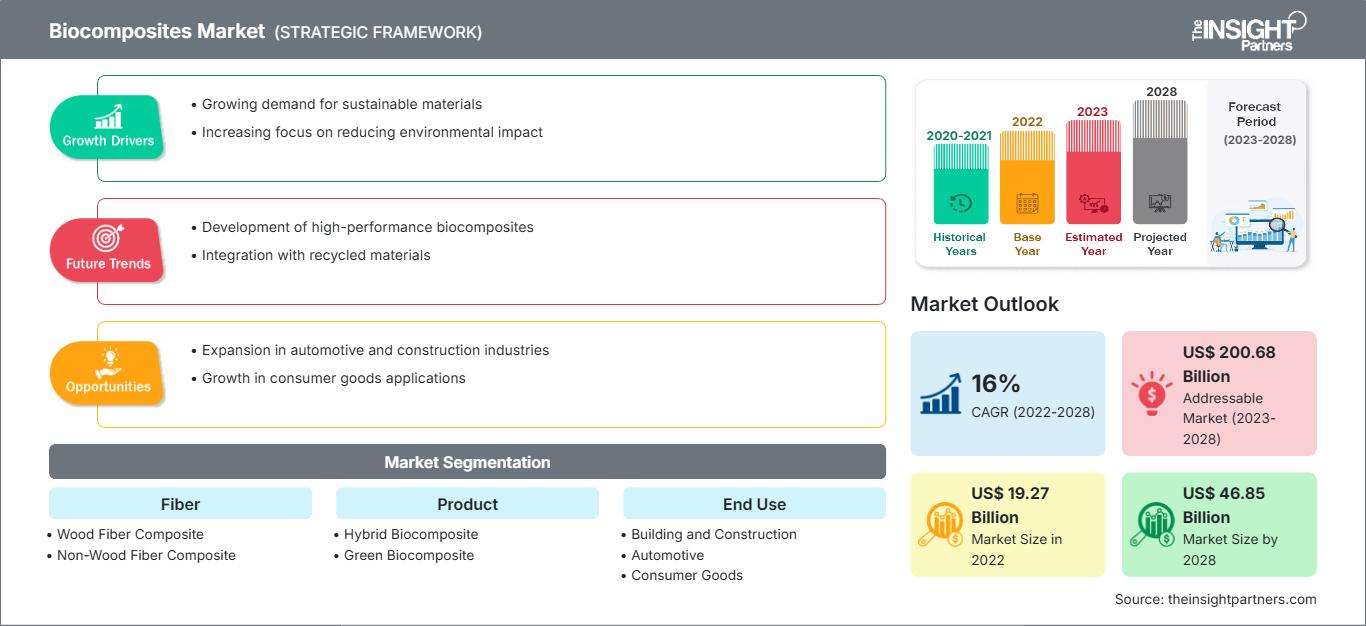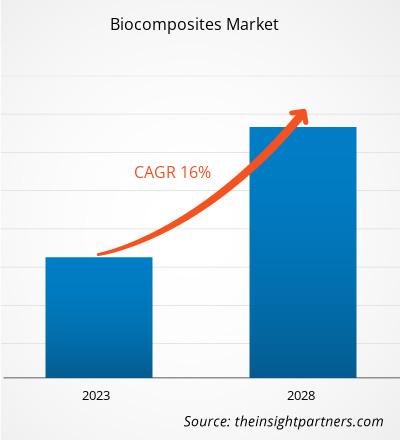[Rapport de recherche] Le marché des biocomposites devrait passer de 19 268,62 millions de dollars américains en 2022 à 46 851,39 millions de dollars américains en 2028 ; sa croissance est estimée à un TCAC de 16 % de 2022 à 2028.
ANALYSE DE MARCHÉ
Les biocomposites sont des matériaux formés par le renforcement de fibres naturelles et d'une matrice (résine). L'intérêt pour les biocomposites croît rapidement parmi les industries d'utilisation finale, notamment en recherche fondamentale, dans l'emballage, la construction, les applications militaires, l'aérospatiale, les wagons de chemin de fer et l'automobile, en raison de nombreux avantages potentiels tels que la facilité de disponibilité, la résistance spécifique élevée, la légèreté, la biodégradabilité, la recyclabilité, le coût réduit et la renouvelabilité. Les biocomposites sont très utilisés dans l'industrie automobile pour la fabrication de panneaux intérieurs. Les biocomposites étant respectueux de l'environnement, ils remplacent les composites polymères dans diverses applications à un prix élevé.
MOTEURS DE CROISSANCE ET DÉFIS
L'utilisation croissante de matériaux de construction durables a contribué à la croissance du marché des biocomposites. Le secteur de la construction est l'un des secteurs émergents les plus dynamiques en matière d'urbanisation rapide en raison de la croissance démographique dans les zones urbaines. Cette urbanisation fait de ce secteur le plus grand consommateur de matériaux, la plupart issus de ressources non renouvelables. Selon le rapport de l'Alliance mondiale pour le bâtiment et la construction, le secteur de la construction est l'un des plus nocifs pour l'environnement. Selon l'étude, le secteur de la construction est responsable de 39 % des émissions de dioxyde de carbone dispersées dans l'environnement, de 36 % de la consommation mondiale d'énergie et de 50 % de l'extraction de matières premières. Les émissions sont principalement responsables du changement climatique et de l'augmentation de la température de la Terre. Les matériaux de construction conventionnels sont très gourmands en ressources et en énergie. Par conséquent, on observe une préoccupation et une prise de conscience croissantes quant aux dangers des matériaux de construction conventionnels, qui ont un impact social et environnemental. Afin de répondre à ces enjeux, de nouveaux matériaux et technologies sont développés dans le secteur de la construction. Les biocomposites sont des matériaux de construction durables qui contribuent à éliminer les déchets non renouvelables, à réduire l'utilisation de matières premières et à diminuer la consommation de combustibles fossiles. L'intérêt pour leur utilisation dans le secteur de la construction est croissant à l'échelle mondiale, car ces matériaux sont issus de sources renouvelables, recyclables et biodégradables et offrent un large éventail d'applications comme éléments de construction structurels et non structurels. Cependant, les composites à base de fibres naturelles présentent quelques inconvénients, tels qu'une mauvaise liaison interfaciale fibre-matrice, une faible mouillabilité et une faible absorption d'eau. Ces difficultés affectent la résistance et les performances des produits finis. La nature hydrophile des biocomposites a tendance à absorber l'eau de l'environnement immédiat, ce qui provoque leur gonflement. Tous ces facteurs devraient freiner la croissance du marché des biocomposites au cours de la période de prévision.
Vous bénéficierez d’une personnalisation sur n’importe quel rapport - gratuitement - y compris des parties de ce rapport, ou une analyse au niveau du pays, un pack de données Excel, ainsi que de profiter d’offres exceptionnelles et de réductions pour les start-ups et les universités
Marché des biocomposites: Perspectives stratégiques

- Obtenez les principales tendances clés du marché de ce rapport.Cet échantillon GRATUIT comprendra une analyse de données, allant des tendances du marché aux estimations et prévisions.
SEGMENTATION ET PORTÉE DU RAPPORT
L'« Analyse du marché mondial des biocomposites à l'horizon 2028 » est une étude spécialisée et approfondie axée sur les tendances et les opportunités de croissance du marché mondial des biocomposites. Ce rapport vise à fournir un aperçu du marché mondial des biocomposites avec une segmentation détaillée par fibre, produit, utilisation finale et zone géographique. Le marché mondial des biocomposites a connu une forte croissance ces dernières années et devrait poursuivre cette tendance au cours de la période de prévision. Le rapport fournit des statistiques clés sur la consommation de biocomposites dans le monde ainsi que sur leur demande dans les principales régions et pays. Il fournit également une évaluation qualitative des différents facteurs affectant la performance du marché des biocomposites dans les principales régions et pays. Il comprend également une analyse complète des principaux acteurs du marché des biocomposites et de leurs principaux développements stratégiques. Plusieurs analyses de la dynamique du marché sont également incluses pour aider à identifier les principaux facteurs moteurs, les tendances du marché et les opportunités lucratives du marché des biocomposites, ce qui permettrait d'identifier les principales sources de revenus.
De plus, l'analyse de l'écosystème et l'analyse des cinq forces de Porter offrent une vue à 360 degrés du marché mondial des biocomposites, ce qui permet de comprendre l'ensemble de la chaîne d'approvisionnement et les différents facteurs affectant la croissance du marché.
ANALYSE SEGMENTAIRE
Le marché mondial des biocomposites est segmenté en fonction de la fibre, du produit et de l'utilisation finale. En fonction de la fibre, le marché des biocomposites est divisé en composites à base de fibres de bois et composites à base de fibres non ligneuses. En fonction du produit, le marché est classé en biocomposites hybrides et biocomposites verts. En fonction de l'utilisation finale, le marché est divisé en bâtiments et construction, automobiles, biens de consommation, etc.
En fonction de la fibre, le segment des composites à base de fibres de bois représentait une part de marché significative des biocomposites. Le principal inconvénient des composites en fibres de bois est leur sensibilité à l'humidité. Cependant, grâce à l'augmentation des travaux de recherche et développement, les fabricants produisent des composants en fibres de bois offrant une meilleure résistance à l'humidité, une plus grande rigidité et un coefficient de dilatation thermique plus faible. Sur la base de ce produit, les composites hybrides dominent le marché des biocomposites avec la plus grande part de marché. En termes d'utilisation finale, le segment du bâtiment et de la construction domine le marché des biocomposites. Dans le bâtiment, les biocomposites sont utilisés pour les charpentes, les murs et les panneaux muraux, les encadrements de fenêtres, les portes, les revêtements de sol, les panneaux décoratifs, les cloisons de cabines et les panneaux de plafond. L'utilisation de biocomposites pour les composants de construction temporaires et ajustables réduit les déchets mis en décharge lors de modifications de l'aménagement intérieur.
ANALYSE RÉGIONALE
Ce rapport fournit un aperçu détaillé du marché mondial des biocomposites pour cinq grandes régions : l'Amérique du Nord, l'Europe, l'Asie-Pacifique (APAC), le Moyen-Orient et l'Afrique (MEA) et l'Amérique du Sud et centrale. L'Asie-Pacifique représente une part importante du marché, évalué à plus de 9 300 millions de dollars US en 2022. Cette région regroupe plusieurs économies en développement et développées, telles que la Chine, l'Inde, le Japon, la Corée du Sud et l'Australie. Le facteur clé de sa croissance est la demande croissante des secteurs du bâtiment, de la construction et des transports pour les industries d'utilisation finale. La forte demande de biocomposites est principalement observée en Chine, au Japon, en Inde et en Corée du Sud. Par ailleurs, l'augmentation des investissements directs étrangers (IDE) dans les secteurs des transports et des infrastructures devrait stimuler la demande de biocomposites au cours des prochaines années. L'Europe devrait également connaître une croissance considérable, évaluée à environ 11 000 millions de dollars US en 2028, en raison de l'augmentation des dépenses publiques consacrées à la construction d'infrastructures. Par ailleurs, en Amérique du Nord, l'utilisation des biocomposites est répandue dans la construction résidentielle et commerciale, les produits de consommation et le secteur automobile. Cela a créé des opportunités lucratives sur le marché des biocomposites. Le marché des biocomposites en Amérique du Nord devrait croître à un TCAC de 15,0 % au cours de la période de prévision.
DÉVELOPPEMENTS DE L'INDUSTRIE ET OPPORTUNITÉS FUTURES
Les partenariats, les acquisitions et les lancements de nouveaux produits se sont avérés être les principales stratégies adoptées par les acteurs opérant sur le marché mondial des biocomposites.
- En mai 2022, Arkema a prévu de lancer sa nouvelle solution pour des composites recyclables et toujours plus performants.
- En mars 2021, Fiberon a annoncé le lancement d'un bardage composite en bois sauvage, offrant la beauté et la chaleur inégalées du bois combinées à la durabilité de matériaux hautes performances et nécessitant peu d'entretien.
Aperçu régional du marché des biocomposites
Les tendances régionales et les facteurs influençant le marché des biocomposites tout au long de la période de prévision ont été analysés en détail par les analystes de The Insight Partners. Cette section aborde également les segments et la géographie du marché des biocomposites en Amérique du Nord, en Europe, en Asie-Pacifique, au Moyen-Orient et en Afrique, ainsi qu'en Amérique du Sud et en Amérique centrale.
Portée du rapport sur le marché des biocomposites
| Attribut de rapport | Détails |
|---|---|
| Taille du marché en 2022 | US$ 19.27 Billion |
| Taille du marché par 2028 | US$ 46.85 Billion |
| TCAC mondial (2022 - 2028) | 16% |
| Données historiques | 2020-2021 |
| Période de prévision | 2023-2028 |
| Segments couverts |
By Fibre
|
| Régions et pays couverts | Amérique du Nord
|
| Leaders du marché et profils d'entreprises clés |
|
Densité des acteurs du marché des biocomposites : comprendre son impact sur la dynamique des entreprises
Le marché des biocomposites connaît une croissance rapide, portée par une demande croissante des utilisateurs finaux, due à des facteurs tels que l'évolution des préférences des consommateurs, les avancées technologiques et une meilleure connaissance des avantages du produit. Face à cette demande croissante, les entreprises élargissent leur offre, innovent pour répondre aux besoins des consommateurs et capitalisent sur les nouvelles tendances, ce qui alimente la croissance du marché.

- Obtenez le Marché des biocomposites Aperçu des principaux acteurs clés
- Analyse historique (2 ans), année de base, prévision (7 ans) avec TCAC
- Analyse PEST et SWOT
- Taille du marché Valeur / Volume - Mondial, Régional, Pays
- Industrie et paysage concurrentiel
- Ensemble de données Excel
Rapports récents
Rapports connexes
Témoignages
Raison d'acheter
- Prise de décision éclairée
- Compréhension de la dynamique du marché
- Analyse concurrentielle
- Connaissances clients
- Prévisions de marché
- Atténuation des risques
- Planification stratégique
- Justification des investissements
- Identification des marchés émergents
- Amélioration des stratégies marketing
- Amélioration de l'efficacité opérationnelle
- Alignement sur les tendances réglementaires




















 Obtenez un échantillon gratuit pour - Marché des biocomposites
Obtenez un échantillon gratuit pour - Marché des biocomposites